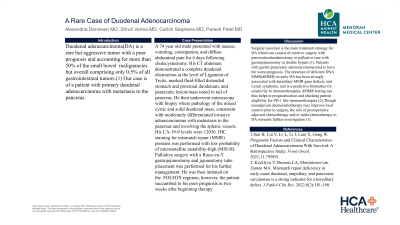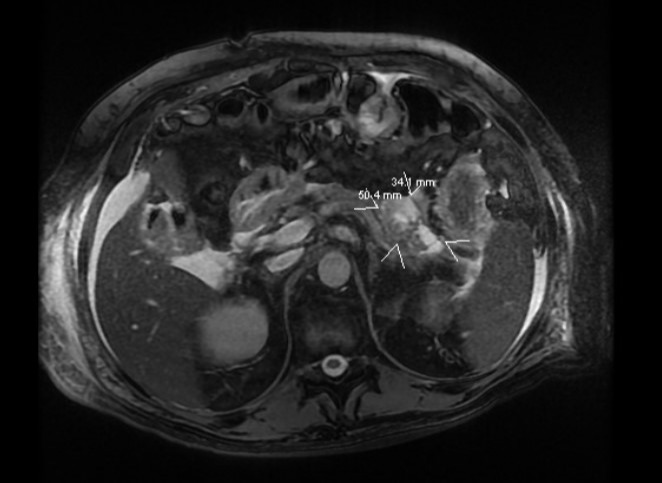Sunday Poster Session
Category: Small Intestine
P1272 - A Rare Case of Duodenal Adenocarcinoma
Sunday, October 22, 2023
3:30 PM - 7:00 PM PT
Location: Exhibit Hall

Has Audio

Alexandria Dennison, MD
HCA
Mission, KS
Presenting Author(s)
Alexandria Dennison, MD, Corbin Stephens, MD, Dae Kim, BS, Paresh Patel, MD, Shruti Verma, MD
HCA, Overland Park, KS
Introduction: Duodenal adenocarcinoma(DA) is a rare but aggressive tumor with a poor prognosis and accounting for more than 50% of the small bowel malignancies but overall comprising only 0.5% of all gastrointestinal tumors.(1) Our case is of a patient with primary duodenal adenocarcinoma with metastasis to the pancreas.
Case Description/Methods: A 74 yo male presented with nausea, vomiting, constipation, and diffuse abdominal pain for 6 days following cholecystectomy. His CT abdomen demonstrated a complete duodenal obstruction at the level of Ligament of Treitz, marked fluid-filled distended stomach and proximal duodenum, and pancreatic lesion/mass noted in tail of pancreas. He then underwent enteroscopy with biopsy where pathology of the mixed cystic and solid duodenal mass, consistent with moderately differentiated invasive adenocarcinoma with metastasis to the pancreas and involving the splenic vessels. His CA-19-9 levels were 12036. IHC staining for mismatch repair (MMR) proteins was performed with low probability of microstallite instability-high (MSI-H). Palliative surgery with a Roux-en-Y gastrojejunostomy and jejunostomy tube placement was performed for his further management. He was then initiated on the FOLFOX regimen, however, the patient succumbed to his poor prognosis in two weeks after beginning therapy.
Discussion: Surgical resection is the main treatment strategy for DA which can consist of curative surgery with pancreaticoduodenectomy or palliative care with gastrojejunostomy or double bypass (1). Patients with gastric/pancreatic adenocarcinoma tend to have the worst prognosis. The presence of deficient DNA MMR(dMMR) in early DA has been strongly associated with hereditary MMR gene defects, and Lynch syndrome, and is a predictive biomarker for sensitivity to immunotherapies. dMMR testing can thus helps in prognostication and checking patient eligibility for PD-1 like immunotherapies (2).Though neoadjuvant chemoradiotherapy may improve local control prior to surgery, the role of postoperative adjuvant chemotherapy and/or radio/chemotherapy in DA warrants further investigation (1).
1.Sun H, Liu Y, Lv L, Li J, Liao X, Gong W. Prognostic Factors and Clinical Characteristics of Duodenal Adenocarcinoma With Survival: A Retrospective Study. Front Oncol. 2021;11:795891.
2. Kryklyva V, Brosens LA, Marijnissen-van Zanten MA. Mismatch repair deficiency in early-onset duodenal, ampullary, and pancreatic carcinomas is a strong indicator for a hereditary defect. J Pathol Clin Res. 2022;8(2):181-190.

Disclosures:
Alexandria Dennison, MD, Corbin Stephens, MD, Dae Kim, BS, Paresh Patel, MD, Shruti Verma, MD. P1272 - A Rare Case of Duodenal Adenocarcinoma, ACG 2023 Annual Scientific Meeting Abstracts. Vancouver, BC, Canada: American College of Gastroenterology.
HCA, Overland Park, KS
Introduction: Duodenal adenocarcinoma(DA) is a rare but aggressive tumor with a poor prognosis and accounting for more than 50% of the small bowel malignancies but overall comprising only 0.5% of all gastrointestinal tumors.(1) Our case is of a patient with primary duodenal adenocarcinoma with metastasis to the pancreas.
Case Description/Methods: A 74 yo male presented with nausea, vomiting, constipation, and diffuse abdominal pain for 6 days following cholecystectomy. His CT abdomen demonstrated a complete duodenal obstruction at the level of Ligament of Treitz, marked fluid-filled distended stomach and proximal duodenum, and pancreatic lesion/mass noted in tail of pancreas. He then underwent enteroscopy with biopsy where pathology of the mixed cystic and solid duodenal mass, consistent with moderately differentiated invasive adenocarcinoma with metastasis to the pancreas and involving the splenic vessels. His CA-19-9 levels were 12036. IHC staining for mismatch repair (MMR) proteins was performed with low probability of microstallite instability-high (MSI-H). Palliative surgery with a Roux-en-Y gastrojejunostomy and jejunostomy tube placement was performed for his further management. He was then initiated on the FOLFOX regimen, however, the patient succumbed to his poor prognosis in two weeks after beginning therapy.
Discussion: Surgical resection is the main treatment strategy for DA which can consist of curative surgery with pancreaticoduodenectomy or palliative care with gastrojejunostomy or double bypass (1). Patients with gastric/pancreatic adenocarcinoma tend to have the worst prognosis. The presence of deficient DNA MMR(dMMR) in early DA has been strongly associated with hereditary MMR gene defects, and Lynch syndrome, and is a predictive biomarker for sensitivity to immunotherapies. dMMR testing can thus helps in prognostication and checking patient eligibility for PD-1 like immunotherapies (2).Though neoadjuvant chemoradiotherapy may improve local control prior to surgery, the role of postoperative adjuvant chemotherapy and/or radio/chemotherapy in DA warrants further investigation (1).
1.Sun H, Liu Y, Lv L, Li J, Liao X, Gong W. Prognostic Factors and Clinical Characteristics of Duodenal Adenocarcinoma With Survival: A Retrospective Study. Front Oncol. 2021;11:795891.
2. Kryklyva V, Brosens LA, Marijnissen-van Zanten MA. Mismatch repair deficiency in early-onset duodenal, ampullary, and pancreatic carcinomas is a strong indicator for a hereditary defect. J Pathol Clin Res. 2022;8(2):181-190.

Figure: Mixed cystic and solid mass involving the pancreatic tail and adjacent bowel at the ligament of Treitz. Measures 5.0 cm transverse, 3.4 cm AP, and 3 cm cephalocaudal.
Disclosures:
Alexandria Dennison indicated no relevant financial relationships.
Corbin Stephens indicated no relevant financial relationships.
Dae Kim indicated no relevant financial relationships.
Paresh Patel indicated no relevant financial relationships.
Shruti Verma indicated no relevant financial relationships.
Alexandria Dennison, MD, Corbin Stephens, MD, Dae Kim, BS, Paresh Patel, MD, Shruti Verma, MD. P1272 - A Rare Case of Duodenal Adenocarcinoma, ACG 2023 Annual Scientific Meeting Abstracts. Vancouver, BC, Canada: American College of Gastroenterology.
